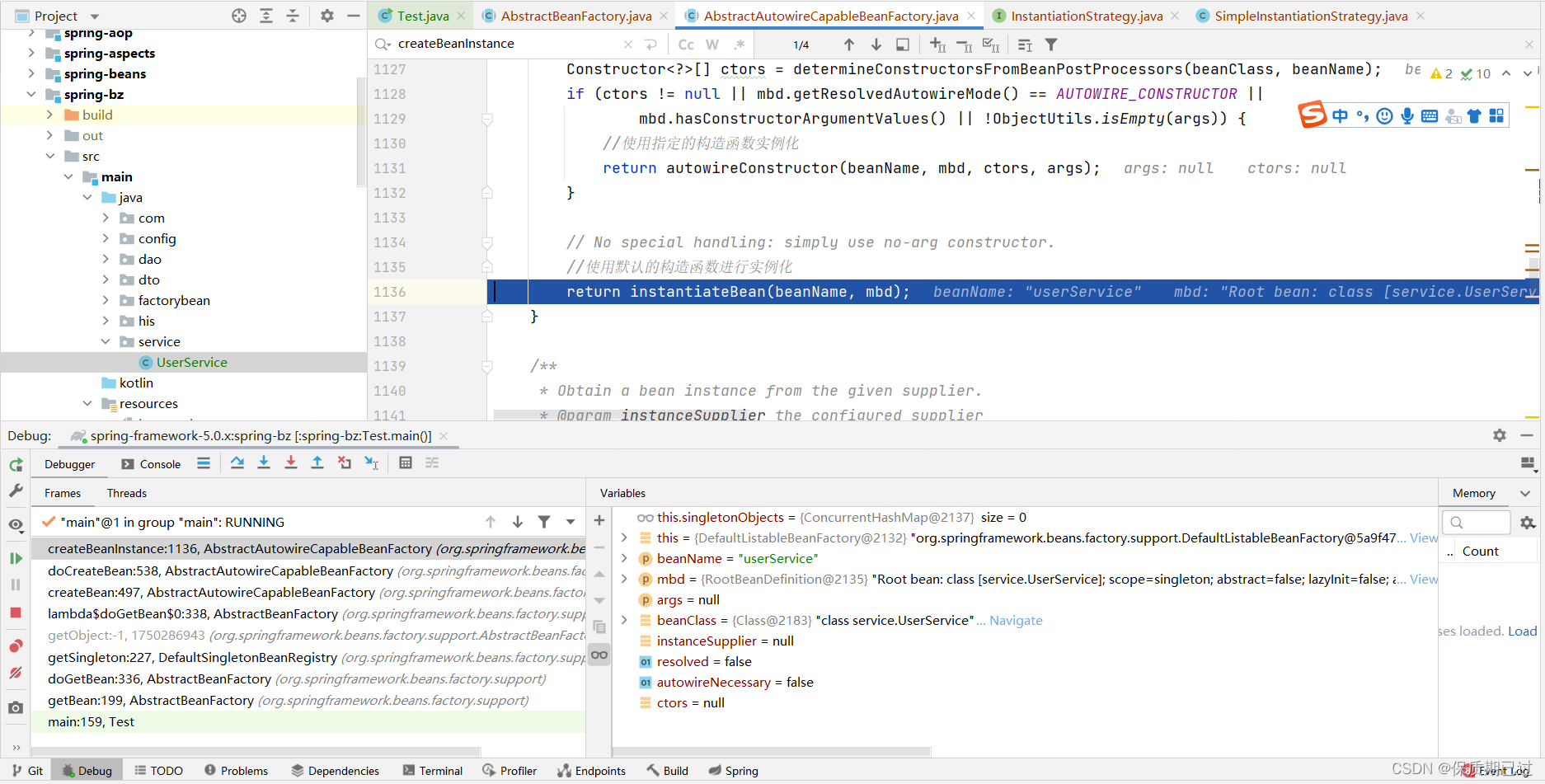spring实例化分为构造函数实例化和静态工厂实例化;当我们没有指定具体的实例化方式时,默认采用无参的构造函数实例化。
一:bean,xml
<bean id="userService" class="service.UserService">
<property name="map">
<map>
<entry key="name" value="test"/>
<entry key="age" value="20"/>
</map>
</property>
<property name="userDto" ref="userDto"></property>
</bean>
二:测试类
public class UserService {
/*public UserService(String name){
System.out.println("进入有参构造函数。。。。。。。。。。。。。。。。。。");
}*/
private UserDto userDto;
private Map<String,String> map;
public UserDto getUserDto() {
return userDto;
}
public void setUserDto(UserDto userDto) {
this.userDto = userDto;
}
public Map<String, String> getMap() {
return map;
}
public void setMap(Map<String, String> map) {
this.map = map;
}
}
通过main方法,进入源码看下具体的实例化流程
public static void main(String[] args) {
//1.资源定位
Resource resource = new ClassPathResource("bean.xml");
//2.创建IOC容器,这里使用DefaultListableBeanFactory作为IOC容器
DefaultListableBeanFactory defaultListableBeanFactory = new DefaultListableBeanFactory();
//3.读取BeanDefinition并注册到IOC容器中
BeanDefinitionReader reader = new XmlBeanDefinitionReader(defaultListableBeanFactory);
reader.loadBeanDefinitions(resource);
//从容器中获取对象
UserService userService = (UserService) defaultListableBeanFactory.getBean("userService");
}
getBean方法是IOC容器实例化的开始的地方,包括依赖注入,通过getBean方法一路跟踪,可以看到bean实例化的具体流程;
具体实例化通过AbstractAutowireCapableBeanFactory类的createBeanInstance方法完成
protected BeanWrapper createBeanInstance(String beanName, RootBeanDefinition mbd, @Nullable Object[] args) {
// Make sure bean class is actually resolved at this point.
Class<?> beanClass = resolveBeanClass(mbd, beanName);
if (beanClass != null && !Modifier.isPublic(beanClass.getModifiers()) && !mbd.isNonPublicAccessAllowed()) {
throw new BeanCreationException(mbd.getResourceDescription(), beanName,
"Bean class isn't public, and non-public access not allowed: " + beanClass.getName());
}
Supplier<?> instanceSupplier = mbd.getInstanceSupplier();
if (instanceSupplier != null) {
return obtainFromSupplier(instanceSupplier, beanName);
}
if (mbd.getFactoryMethodName() != null) {
//静态工厂方法实例化
return instantiateUsingFactoryMethod(beanName, mbd, args);
}
// Shortcut when re-creating the same bean...
boolean resolved = false;
boolean autowireNecessary = false;
if (args == null) {
synchronized (mbd.constructorArgumentLock) {
if (mbd.resolvedConstructorOrFactoryMethod != null) {
resolved = true;
autowireNecessary = mbd.constructorArgumentsResolved;
}
}
}
if (resolved) {
if (autowireNecessary) {
return autowireConstructor(beanName, mbd, null, null);
}
else {
return instantiateBean(beanName, mbd);
}
}
// Candidate constructors for autowiring?
//使用构造函数进行实例化
Constructor<?>[] ctors = determineConstructorsFromBeanPostProcessors(beanClass, beanName);
if (ctors != null || mbd.getResolvedAutowireMode() == AUTOWIRE_CONSTRUCTOR ||
mbd.hasConstructorArgumentValues() || !ObjectUtils.isEmpty(args)) {
//使用指定的构造函数实例化
return autowireConstructor(beanName, mbd, ctors, args);
}
// No special handling: simply use no-arg constructor.
//使用默认的构造函数进行实例化
return instantiateBean(beanName, mbd);
}
调用instantiateBean
调用InstantiationStrategy的instantiate方法,instantiate方法是接口,由实现类SimpleInstantiationStrategy完成实例化
public Object instantiate(RootBeanDefinition bd, @Nullable String beanName, BeanFactory owner) {
// Don't override the class with CGLIB if no overrides.
if (!bd.hasMethodOverrides()) {
Constructor<?> constructorToUse;
synchronized (bd.constructorArgumentLock) {
//取得指定的构造器或者生成对象工厂方法来对bean进行实例化
constructorToUse = (Constructor<?>) bd.resolvedConstructorOrFactoryMethod;
if (constructorToUse == null) {
//获取bean的Class
final Class<?> clazz = bd.getBeanClass();
if (clazz.isInterface()) {
//如果Class是接口,则抛出异常
throw new BeanInstantiationException(clazz, "Specified class is an interface");
}
try {
if (System.getSecurityManager() != null) {
constructorToUse = AccessController.doPrivileged(
(PrivilegedExceptionAction<Constructor<?>>) clazz::getDeclaredConstructor);
}
else {
//通过Class获取无参构造器
constructorToUse = clazz.getDeclaredConstructor();
}
bd.resolvedConstructorOrFactoryMethod = constructorToUse;
}
catch (Throwable ex) {
throw new BeanInstantiationException(clazz, "No default constructor found", ex);
}
}
}
//通过BeanUtils进行实例化
return BeanUtils.instantiateClass(constructorToUse);
}
else {
// Must generate CGLIB subclass.
//使用CGLIB实例化对象
return instantiateWithMethodInjection(bd, beanName, owner);
}
}
通过BeanUtils.instantiateClass进行实例化
通过构造器的newInstance方法实例化,并将实例化的结果返回,并进行属性注入等后续操作
public static <T> T instantiateClass(Constructor<T> ctor, Object... args) throws BeanInstantiationException {
Assert.notNull(ctor, "Constructor must not be null");
try {
ReflectionUtils.makeAccessible(ctor);
//通过反射实例化
return (KotlinDetector.isKotlinType(ctor.getDeclaringClass()) ?
KotlinDelegate.instantiateClass(ctor, args) : ctor.newInstance(args));
}
catch (InstantiationException ex) {
throw new BeanInstantiationException(ctor, "Is it an abstract class?", ex);
}
catch (IllegalAccessException ex) {
throw new BeanInstantiationException(ctor, "Is the constructor accessible?", ex);
}
catch (IllegalArgumentException ex) {
throw new BeanInstantiationException(ctor, "Illegal arguments for constructor", ex);
}
catch (InvocationTargetException ex) {
throw new BeanInstantiationException(ctor, "Constructor threw exception", ex.getTargetException());
}
}























 2003
2003











 被折叠的 条评论
为什么被折叠?
被折叠的 条评论
为什么被折叠?








